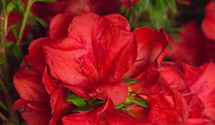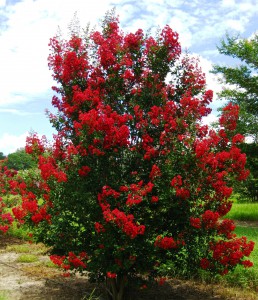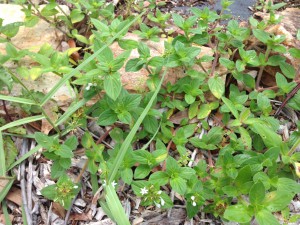
by Sheila Dunning | Feb 3, 2015
Nothing signals spring in the south like the reds, pinks and whites of azaleas in full bloom. Nearly every yard has one. For two weeks out of the year there are flowers everywhere. But the glory fades fast. That was, until the late 90’s.
Twenty-eight Encore® azaleas have been released since 1998. Robert E “Buddy” Lee, an avid collector and azalea breeder from Independence, Louisiana initiated an azalea breeding program to incorporate fall blooming characteristics into a winter hardy, evergreen azalea. He started his work in the 1980s, working out of his home with the goal of bringing the beauty of spring azaleas to other seasons. As the project grew, he eventually teamed up with Flowerwood Nursery to continue the process that would bring Encore® azaleas to the public. And, this spring number 29, Autumn Fire™ , a true red dwarf will be released, nearly a year ahead of  its original predicted introduction date.
its original predicted introduction date.
Lee selected the seedling that was to be named Autumn Amethyst™ in 1986, but did not receive the plant patent until 1998. So far, there are two series of Encore® azaleas: the Autumn series and the Southern series. The Autumn series can be grown in Zone 7 or warmer. The Southern series was designed for even warmer climates; they can be grown in Zone 8 or warmer. The Southern varieties are especially good for the Florida panhandle and the Mississippi and Alabama gulf coasts.
Different parents were used for the various cultivars now available. The fall flowering trait primarily comes from Rhododendron oldhamii Fourth of July – a cultivar selected from seed collected in 1968 at 2,500 feet up Taiwan’s Mount Tai Tun. The female parent used to create Autumn Amethyst™ was a winter hardy hybrid named ‘Karens’ a cross between ‘Hinodegini’, the old Kurume variety, and R. yedoensis var. poukhanense, the Korean azalea.
At the 2015 Gulf States Horticultural Expo last week, I got to see Autumn Fire™ in full bloom. It is a bright cherry red with 2.5” blooms, on a nice compact 2.5’ X 3’ dwarf plant. I think it’s a keeper. Encore® azaleas are available in an array of colors, growth forms and bloom characteristics. New hybrids provide the traditional spring display during March and April, but they also bloom again in the fall, usually during September or early October. They reliably bloom in the spring and fall, but are never quite as covered with a complete carpet of flowers as you might see on a traditional azalea.
Encore® azaleas have the same cultural requirements as traditional azaleas. They should have a pH between 5.0 and 5.5, a well drained organic soil and water during the summer months. Bloom is heavier in brighter locations, with areas having morning sun and afternoon shade probably the best. If pruning is required to control size, thin and shear them in the spring just after bloom.

by Gary Knox | Feb 3, 2015

Figure 1. Topping is the drastic removal of large-diameter wood (typically several years old) with the end result of shortening all stems and branches. Topping is not recommended for crapemyrtle.
As the holidays fade and the New Year begins, we often see crapemyrtles being “mutilated” from improper pruning: main stems that are several years old are cut back, often leaving branch stubs 2 – 5 inches or more in diameter. This form of crapemyrtle mistreatment goes by various names, including topping, heading, stubbing, rounding, dehorning and (my favorite) “crape murder”.
Whatever you call it, topping a crapemyrtle is almost always unnecessary. Over the years, many people viewed this type of improper pruning and unthinkingly perpetuated the practice in their own yards, not realizing the unfortunate consequences.
Research at the University of Florida found that topping crapemyrtle delays flowering up to one month. For example, unpruned trees may begin flowering in June whereas topped trees begin flowering in July. This research also found topping reduced the number of flowers and shortened the flowering season. Finally, topping stimulated more summer sprouting from roots and stems. Sprouting results in greater maintenance since sprouts are usually removed to maintain an attractive plant appearance.

Figure 2. With proper cultivar selection and placement in the landscape, crapemyrtle develops into a beautifully shaped tree that rarely needs pruning. This crapemyrtle is Red Rocket®.
If a crapemyrtle is located where it requires routine pruning to fit into its surroundings (for example, under the eave of a roof), it should be replaced with a smaller growing crapemyrtle. A dwarf crapemyrtle (maturing at a height of 5 feet) would fit this location well. Medium crapemyrtle cultivars (growing up to about 15 feet in height) and tall or tree-size crapemyrtle cultivars (often growing 20 – 30 feet tall in 10 years) are best reserved for open areas.
Crapemyrtle thrives under full sun conditions in areas with ample room for the cultivar size and away from walkways and roads. Proper selection of crapemyrtle cultivar and proper placement in the landscape can result in a low maintenance crapemyrtle without the need for significant pruning.
For more information, please see Crapemyrtle Pruning.
by Mary Salinas | Feb 2, 2015
So often, homeowners wait until weeds have overtaken their lawns in mid-summer before looking for a course of action to control them. Unfortunately, when weeds get to maturity and start producing flowers and going to seed, they are usually quite difficult to control.
[important]The best strategy is to prevent the weeds from getting established in the first place![/important]

Florida pusley, an annual weed that can be controlled with preemergence herbicides. Photo credit: Mary Derrick UF/IFAS Extension.
When properly applied, a preemergence herbicide forms a chemical barrier on the surface of the soil that kills newly germinated seeds when they grow and contact that barrier. Be sure to follow label directions carefully as it is crucial to apply the correct amount and water it in correctly. The soil surface should not be disturbed after application to ensure that the chemical barrier remains intact.
Keep in mind that preemergence herbicides only prevent annual weeds! They do not control weeds that have already emerged.
In North Florida, the time to apply a preemergence herbicide to your turfgrass is coming soon. As a general rule, March 1 is an ideal time. Another indicator that the time is right is when the daytime temperatures reach 65°F-70°F for 4 to 5 consecutive days as that sustained warmth will prompt weed seeds to germinate. Oftentimes, this is also when azaleas or dogwoods start blooming and that can clue you into when to apply the herbicide. For best results, follow up with a second application in 6 to 9 weeks to control those seeds germinating later in the season.
Always follow the label instructions precisely when applying any herbicide! Ensure that you apply the product at the correct rate, that it is suitable for your specific turfgrass and situation, and that it is watered in correctly. For any pesticide, the label is the law!
If your lawn has problems with winter weeds, make a note on your calendar to apply a preemergence herbicide about October 1 in North Florida or when nighttime temperatures drop to 55°F-60°F for several consecutive days.
For more information on weed control in lawns:
Weed Management Guide for Florida Lawns
For general information on lawn care in Florida:
UF/IFAS Gardening Solutions: Lawns

 its original predicted introduction date.
its original predicted introduction date.



